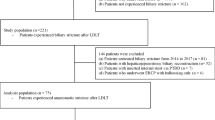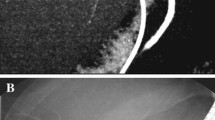Abstract
Purpose
Internal biliary stenting (IBS) was reported to decrease biliary complications after liver transplantation (LT) but data in literature is scarce. The aim of the present study was to evaluate our experience with end-to-end choledoco-choledocostomy during liver transplantation with special focus on the influence of IBS on patient and biliary outcomes.
Methods
Between 2009 and 2013, 175 patients underwent deceased donor LT with end-to-end choledoco-choledocostomy and were included in the study. Supra-papillary silastic stent was inserted in 67 patients (38%) with small-size (< 5 mm) bile ducts (recipient or donor). Endoscopic retrograde cholangiopancreatography (ERCP) was scheduled for IBS removal, 6 months after LT. Operative outcomes and survival of patients who received internal stenting (IBS group) were compared with those of patients who did not (no-IBS group). Risk factors for biliary anastomotic complications were identified.
Results
Ten patients died (6%) and 104 (59%) experienced postoperative complications. Five-year patient and graft survival rates were 77 and 74%, respectively. Biliary complications were recorded in 61 patients (35%) and were significantly decreased by IBS insertion (p = 0.0003). Anastomotic fistulas occurred in 23 patients (13%) and stenoses in 44 patients (25%). On multivariate analysis, high preoperative MELD scores (p = 0.02) and hepatic artery thrombosis (p < 0.0001) were predictors of fistula; absence of IBS was associated with both fistula (p = 0.014) and stricture (p = 0.003) formation.
Conclusions
IBS insertion during LT decreases anastomotic complication.



Similar content being viewed by others
References
Tranchart H, Zalinski S, Sepulveda A, Chirica M, Prat F, Soubrane O, Scatton O (2012) Removable intraductal stenting in duct-to-duct biliary reconstruction in liver transplantation. Transpl Int 25:19–24. https://doi.org/10.1111/j.1432-2277.2011.01339.x
Welling TH, Heidt DG, Englesbe MJ, Magee JC, Sung RS, Campbell DA, Punch JD, Pelletier SJ (2008) Biliary complications following liver transplantation in the model for end-stage liver disease era: effect of donor, recipient, and technical factors. Liver Transpl 14:73–80. https://doi.org/10.1002/lt.21354
Seehofer D, Eurich D, Veltzke-Schlieker W, Neuhaus P (2013) Biliary complications after liver transplantation: old problems and new challenges. Am J Transplant 13:253–265. https://doi.org/10.1111/ajt.12034
Akamatsu N, Sugawara Y, Hashimoto D (2011) Biliary reconstruction, its complications and management of biliary complications after adult liver transplantation: a systematic review of the incidence, risk factors and outcome. Transpl Int 24:379–392. https://doi.org/10.1111/j.1432-2277.2010.01202.x
Goumard C, Cachanado M, Herrero A, Rousseau G, Dondero F, Compagnon P, Boleslawski E, Mabrut JY, Salamé E, Soubrane O, Simon T, Scatton O (2015) Biliary reconstruction with or without an intraductal removable stent in liver transplantation: study protocol for a randomized controlled trial. Trials 16:598. https://doi.org/10.1186/s13063-015-1139-6
Johnson MW, Thompson P, Meehan A, Odell P, Salm MJ, Gerber DA, Zacks SL, Fried MW, Shrestha R, Fair JH (2000) Internal biliary stenting in orthotopic liver transplantation. Liver Transpl 6:356–361. https://doi.org/10.1053/lv.2000.5303
Barkun JS, Tzimas GN, Cantarovich M, Metrakos PP, Deschênes M, Alpert E, Paraskevas S, Tchervenkov JI (2003) Do biliary endoprostheses decrease biliary complications after liver transplantation? Transplant Proc 35:2435–2437
Bawa SM, Mathew A, Krishnan H, Minford E, Talbot D, Mirza DF, Thick MG, Gibbs P, Manas D (1998) Biliary reconstruction with or without an internal biliary stent in orthotopic liver transplantation: a prospective randomised trial. Transpl Int 11(Suppl 1):S245–S247
Mathur AK, Nadig SN, Kingman S, Lee D, Kinkade K, Sonnenday CJ, Welling TH (2015) Internal biliary stenting during orthotopic liver transplantation: anastomotic complications, post-transplant biliary interventions, and survival. Clin Transpl 29:327–335. https://doi.org/10.1111/ctr.12518
Grande L, Pérez-Castilla A, Matus D, Rodriguez-Montalvo C, Rimola A, Navasa M, García-Valdecasas JC, Visa J (1999) Routine use of the T tube in the biliary reconstruction of liver transplantation: is it worthwhile? Transplant Proc 31:2396–2397
Weiss S, Schmidt S-C, Ulrich F, Pascher A, Schumacher G, Stockmann M, Puhl G, Guckelberger O, Neumann UP, Pratschke J, Neuhaus P (2009) Biliary reconstruction using a side-to-side choledochocholedochostomy with or without T-tube in deceased donor liver transplantation. Ann Surg 250:766–771. https://doi.org/10.1097/SLA.0b013e3181bd920a
Wojcicki M, Milkiewicz P, Silva M (2008) Biliary tract complications after liver transplantation: a review. Dig Surg 25:245–257. https://doi.org/10.1159/000144653
Riediger C, Müller MW, Michalski CW, Hüser N, Schuster T, Kleeff J, Friess H (2010) T-tube or no T-tube in reconstruction of the biliary tract during orthotopic liver transplantation—systematic review and meta-analysis. Liver Transpl NA–NA:NA. https://doi.org/10.1002/lt.22070
Shimoda M, Saab S, Morrisey M et al (2001) A cost-effectiveness analysis of biliary anastomosis with or without T-tube after orthotopic liver transplantation. Am J Transplant 1:157–161
Scatton O, Meunier B, Cherqui D, Boillot O, Sauvanet A, Boudjema K, Launois B, Fagniez PL, Belghiti J, Wolff P, Houssin D, Soubrane O (2001) Randomized trial of choledochocholedochostomy with or without a T tube in orthotopic liver transplantation. Ann Surg 233:432–437
Sotiropoulos GC, Sgourakis G, Radtke A, Molmenti EP, Goumas K, Mylona S, Fouzas I, Karaliotas C, Lang H (2009) Orthotopic liver transplantation: T-tube or not T-tube? Systematic review and meta-analysis of results. Transplantation 87:1672–1680. https://doi.org/10.1097/TP.0b013e3181a5cf3f
Paes-Barbosa FC, Massarollo PC, Bernardo WM, Ferreira FG, Barbosa FK, Raslan M, Szutan LA (2010) Systematic review and meta-analysis of biliary reconstruction techniques in orthotopic deceased donor liver transplantation. J Hepato-Biliary-Pancreat Sci 18:525–536. https://doi.org/10.1007/s00534-010-0346-5
Amador A, Charco R, Martí J, Navasa M, Rimola A, Calatayud D, Rodriguez-Laiz G, Ferrer J, Romero J, Ginesta C, Fondevila C, Fuster J, García-Valdecasas JC (2007) Clinical trial on the cost-effectiveness of T-tube use in an established deceased donor liver transplantation program. Clin Transpl 21:548–553. https://doi.org/10.1111/j.1399-0012.2007.00688.x
Saab S (2000) Endoscopic management of biliary leaks after t-tube removal in liver transplant recipients: nasobiliary drainage versus biliary stenting. Liver Transpl 6:627–632. https://doi.org/10.1053/jlts.2000.8200
Starzl TE, Miller C, Broznick B, Makowka L (1987) An improved technique for multiple organ harvesting. Surg Gynecol Obstet 165:343–348
Koch M, Garden OJ, Padbury R et al (2011) Bile leakage after hepatobiliary and pancreatic surgery: a definition and grading of severity by the International Study Group of Liver Surgery. Surgery 149:680–688. https://doi.org/10.1016/j.surg.2010.12.002
Dindo D, Demartines N, Clavien P-A (2004) Classification of surgical complications: a new proposal with evaluation in a cohort of 6336 patients and results of a survey. Ann Surg 240:205–213
Sawyer RG, Punch JD (1998) Incidence and management of biliary complications after 291 liver transplants following the introduction of transcystic stenting. Transplantation 66:1201–1207
Verdonk RC, Buis CI, Porte RJ, van der Jagt EJ, Limburg AJ, van den Berg AP, Slooff MJH, Peeters PMJG, de Jong KP, Kleibeuker JH, Haagsma EB (2006) Anastomotic biliary strictures after liver transplantation: causes and consequences. Liver Transpl 12:726–735. https://doi.org/10.1002/lt.20714
Baccarani U, Isola M, Adani GL, Avellini C, Lorenzin D, Rossetto A, Currò G, Comuzzi C, Toniutto P, Risaliti A, Soldano F, Bresadola V, de Anna D, Bresadola F (2010) Steatosis of the hepatic graft as a risk factor for post-transplant biliary complications. Clin Transpl 24:631–635
Park JB, Kwon CHD, Choi G-S, Chun JM, Jung GO, Kim SJ, Joh JW, Lee SK (2008) Prolonged cold ischemic time is a risk factor for biliary strictures in duct-to-duct biliary reconstruction in living donor liver transplantation. Transplantation 86:1536–1542. https://doi.org/10.1097/TP.0b013e31818b2316
Marubashi S, Dono K, Nagano H, Kobayashi S, Takeda Y, Umeshita K, Monden M, Doki Y, Mori M (2009) Biliary reconstruction in living donor liver transplantation: technical invention and risk factor analysis for anastomotic stricture. Transplantation 88:1123–1130. https://doi.org/10.1097/TP.0b013e3181ba184a
Qian YB, Liu CL, Lo CM (1960) Fan ST (2004) risk factors for biliary complications after liver transplantation. Arch Surg Chic Ill 139:1101–1105. https://doi.org/10.1001/archsurg.139.10.1101
Verran DJ, Asfar SK, Ghent CN, Grant DR, Wall WJ (1997) Biliary reconstruction without T tubes or stents in liver transplantation: report of 502 consecutive cases. Liver Transpl Surg 3:365–373
Seo JK, Ryu JK, Lee SH, Park JK, Yang KY, Kim YT, Yoon YB, Lee HW, Yi NJ, Suh KS (2009) Endoscopic treatment for biliary stricture after adult living donor liver transplantation. Liver Transpl 15:369–380. https://doi.org/10.1002/lt.21700
Kasahara M, Egawa H, Takada Y, Oike F, Sakamoto S, Kiuchi T, Yazumi S, Shibata T, Tanaka K (2006) Biliary reconstruction in right lobe living-donor liver transplantation: comparison of different techniques in 321 recipients. Ann Surg 243:559–566. https://doi.org/10.1097/01.sla.0000206419.65678.2e
Tashiro H, Itamoto T, Sasaki T, Ohdan H, Fudaba Y, Amano H, Fukuda S, Nakahara H, Ishiyama K, Ohshita A, Kohashi T, Mitsuta H, Chayama K, Asahara T (2007) Biliary complications after duct-to-duct biliary reconstruction in living-donor liver transplantation: causes and treatment. World J Surg 31:2222–2229
Sánchez-Cabús S, Calatayud D, Ferrer J, Molina V, Pavel MC, Sampson J, Saavedra D, Fondevila C, Fuster J, García-Valdecasas JC (2016) Beneficial effect of a resorbable biliary stent in living donor liver transplantation. Eur Surg Res 56:123–131. https://doi.org/10.1159/000443271
Author information
Authors and Affiliations
Contributions
Seven authors make substantial contributions to the development of this manuscript. Girard, O. Risse, V. Leroy, and C. Letoublon design the study; E. Girard, O. Risse, and J. Abba performed acquisition of data; M. Medici and M. Chirica made data analysis. E. Girard and M. Chirica wrote the paper; O. Risse, J. Abba, M. Medici, V. Leroy, and C. Letoublon reviewed the paper.
Corresponding author
Ethics declarations
Conflict of interest
The authors declare that they have no conflict of interest.
Ethical approval
All procedures performed in studies involving human participants were in accordance with the ethical standards of the institutional and/or national research committee and with the 1964 Helsinki declaration and its later amendments or comparable ethical standards.
Informed consent
Informed consent was obtained from all individual participants included in the study.
Rights and permissions
About this article
Cite this article
Girard, E., Risse, O., Abba, J. et al. Internal biliary stenting in liver transplantation. Langenbecks Arch Surg 403, 487–494 (2018). https://doi.org/10.1007/s00423-018-1669-y
Received:
Accepted:
Published:
Issue Date:
DOI: https://doi.org/10.1007/s00423-018-1669-y




